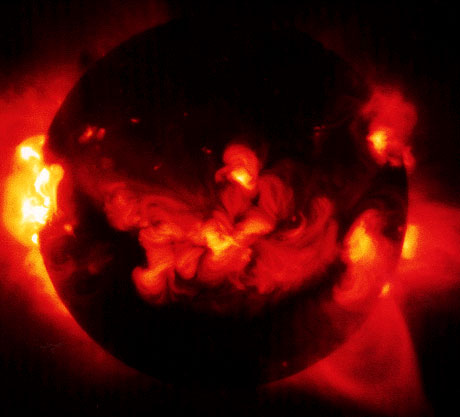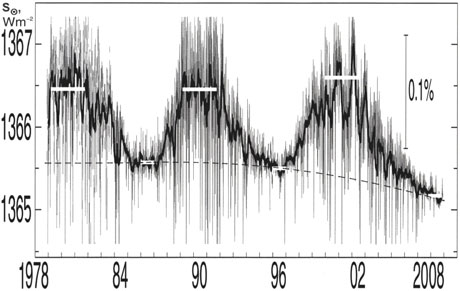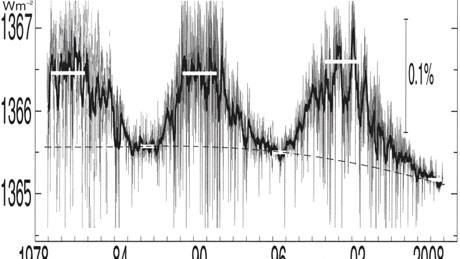The Sun Defines The Climate
Source: gao.spb.ru

Habibullo Abdussamatov, Dr. Sc.
Head of Space research laboratory of the Pulkovo Observatory,
Head of the Russian/Ukrainian joint project Astrometria
(translated from Russian by Lucy Hancock)
Experts of the United Nations in regular reports publish data said to show that the Earth is approaching a catastrophic global warming, caused by increasing emissions of carbon dioxide to the atmosphere. However, observations of the Sun show that as for the increase in temperature, carbon dioxide is "not guilty" and as for what lies ahead in the upcoming decades, it is not catastrophic warming, but a global, and very prolonged, temperature drop.
Life on earth completely depends on solar radiation, the ultimate source of energy for natural processes. For a long time it was thought that the luminosity of the Sun never changes, and for this reason the quantity of solar energy received per second over one square meter above the atmosphere at the distance of the Earth from the Sun (149 597 892 km), was named the solar constant.
Until 1978, precise measurements of the value of the total solar irradiance (TSI) were not available. But according to indirect data, namely the established major climate variations of the Earth in recent millennia, one must doubt the invariance of its value.
In the middle of the nineteenth century, German and Swiss astronomers Heinrich Schwabe and Rudolf Wolf established that the number of spots on the surface of the Sun periodically changes, diminishing from a maximum to a minimum, and then growing again, over a time frame on the order of 11 years. Wolf introduced an index (“W”) of the relative number of sunspots, computed as the sum of 10 times number of sunspot groups plus the total number of spots in all groups. This number has been regularly measured since 1849. Drawing on the work of professional astronomers and the observations of amateurs (which are of uncertain reliability) Wolf worked out a reconstruction of monthly values from 1749 as well as annual values from 1700. Today, the reconstruction of this time series stretches back to 1611. It has an eleven-year cycle of recurrence as well as other cycles related to onset and development of individual sunspot groups: changes in the fraction of the solar surface occupied by faculae, the frequency of prominences, and other phenomena in the solar chromosphere and corona.
Analyzing the long record of sunspot numbers, the English astronomer Walter Maunder in 1893 came to the conclusion that from 1645 to 1715 sunspots had been generally absent. Over the thirty-year period of the Maunder Minimum, astronomers of the time counted only about 50 spots. Usually, over that length of time, about 50,000 sunspots would appear. Today, it has been established that such minima have repeatedly occurred in the past. It is also known that the Maunder Minimum accompanied the coldest phase of a global temperature dip, physically measured in Europe and other regions, the most severe such dip for several millennia, which stretched from the fourteenth to the nineteenth centuries (now known as the Little Ice Age).
The search for a relationship between large climate variations and phenomena observed in the Sun led to an interest in finding a connection between periods of change in the terrestrial climate and corresponding significant changes in the level of observed solar activity, because the sunspot number is the only index that has been measured over a long period of time.
Variations in solar activity and climate
Analyzing data on solar activity, the American astrophysicist John Eddy in 1976 noted a correlation between periods of significant change in the number of spots in the past millennium and large changes in the climate of the Earth, changes that have profoundly influenced the life of peoples and states, initiating economic and demographic crises. Later, St. Petersburg geophysicist Eugene Borisenkov showed (1988) that in each of 18 deep minima of solar activity of the Maunder Minimum type, minima which have occurred about every 200 years for the last 7500 years, there have been periods of deep temperature decline, while in the periods of high sunspot maxima, there have been periods of global warming. Such changes in the climate of the Earth could be caused only by lasting and significant changes in the Sun, because there was absolutely no industrial effect on nature in those times. This supports the idea that in the bicentennial periods of maximum levels of solar activity, the TSI has always substantially increased, and it has noticeably decreased in periods of minima.
Thus, not 11-year, but bicentennial cycles of solar variation are the dominant factor in climate variations that last for decades: temperatures in the ocean-atmosphere system, the physical parameters of the earth’s surface and its albedo, concentrations of greenhouse gases (primarily water vapor and carbon dioxide) in the atmosphere. Also, a quite important influence on climate is exerted by the world ocean, which possesses large thermal inertia and serves as the principal receiver and storage of solar energy.
Variation in the temperature in the interior of the Sun
Changes in the temperature of the Sun’s core result in corresponding changes of pressure; equilibrium is disrupted. Fluctuations of the energy of thermonuclear fusion in the solar core may be the cause of the transience of the thermodynamic state of the Sun. Long-period radial motions of plasma, cyclically reversing direction depending on changes in the temperature, must be taking place within the Sun. These radial motions of plasma in turn may catalyze change in the number of sunspots and the TSI. The additional energy released in solar core may be the source of energy for these motions.
The amplitude of fluctuations of the temperature of the solar core, and in turn of the radius of the Sun, would determine the power of the solar cycle. Small amplitudes may initiate weak cycles (i.e., where the increase in the level of activity and the value of TSI are small), and large amplitudes initiate powerful cycles. A missing change, or very small one, in the temperature of the solar core at its minimum could lead to deep “downfall” similar to the Maunder minimum.
Consequently, the precise value of the radius of the Sun and its relative changes serve as parameters of the first importance and are among basic indicators of the value of the TSI and the level of activity of sunspot formation.

Fig. 1. Variation in the TSI during the period 1978 to 2008 (heavy line) and its bicentennial component (dash line), revealed by us. Distinct short-term upward excursions are caused by the passage of faculae on the solar disk, and downward excursions by the passage of sunspot groups. (Graph is taken from the site www.pmodwrc.ch/pmod.php?topic=tsi/composite/SolarConstant)
Prediction of variations in solar cycles 24 to 27
The changing gradient of the bicentennial component of variation in the TSI observed over three consecutive “short” cycles (Fig. 1) delineates further dynamics in the value of the TSI and the level of solar activity, not only of these cycles but also subsequent cycles although with somewhat smaller accuracy. From this consideration, the most probable maximum in the next, the 24th, solar cycle, will be at sunspot number 65 ± 15. But in the subsequent cycles 25-26, falling in the present bicentennial cycle’s phase of active decrease, the trend toward reduction in the absolute value of the TSI will persist, together with decrease in the level of corresponding maxima in solar activity to 45 ± 20 and sunspot number to 30 ± 20 (Fig. 3, 5). Therefore we would expect the onset of the phase of deep minimum in the present 200-year cycle of cyclic activity of the Sun to occur at the beginning of solar cycle 27; i.e., tentatively in the year 2042 plus or minus 11 years, and potentially lasting 45-65 years.
Warming on Mars and other planets
A global increase in temperature has also occurred on Mars. NASA researchers, after tracing changes on its surface from 1999 until 2005, discovered melting ice at Mars’ south pole and warming of the Martian climate, a natural event that occurred without any contribution by Martians or greenhouse effect driven by Martians. Analogous processes have also been observed on Jupiter, Neptune, Triton, Pluto and other planets of the solar system. These can only be the direct consequences of the action of one and the same factor - the prolonged and extraordinarily high level of the energy radiated by the Sun.
Warming on Mars did not occur as a result of change in the shape of its orbit and inclination of its axis of rotation, as is frequently asserted: these processes occur on time frames of tens of thousands of years, and therefore in this negligible time frame (six years!) in no way could they affect the climate. The recently-observed dust storms on Mars could arise as a result of uneven heating of various regions on the surface of planet by anomalously intensive solar radiation. Warming in turn led to change in the surfaces of planets so that they absorb more solar energy, and the physical properties of planetary atmospheres changed. These indirect results of the influence of the Sun caused increase in temperature additional to that directly caused by the bicentennial increase in the TSI.
According to the calculations carried out both in our laboratory and by foreign colleagues, the direct influence of a bicentennial variation in the TSI accounts for only about half of the amplitude of change in the global temperature of the Earth and only at first. The other half is an indirect impact: with a change in the temperature comes a change in the reflectivity of the earth's surface and change in the concentration of water vapor, carbon dioxide and other greenhouse gases in the atmosphere, each of which additionally and sharply accelerates further change in temperature.
There is no ocean on Mars; therefore its thermal inertia is much lower, and cooling begins much faster than the Earth. A drop in its temperature is a harbinger of temperature drop on Earth.
Influence of water vapor and carbon dioxide
Calculations carried out in our laboratory have showed that the energy absorbed by CO2 (in the absorption bands 2.2-3 ìm; 3.6-4.7 ìm; 12.8-17.3 ìm) and water vapour H2O (4.4-8.8 ìm; 5.5-7.5 ìm; 15-30 ìm and more than 20 ìm), constitute approximately 63% of the entire thermal radiation of the Earth. About 51% is absorbed by water vapor and only about 12% by carbon dioxide. The Earth's atmosphere transmits about 10% of its own thermal emission into space, and the remaining 27% is absorbed by clouds and molecules of other greenhouse gases, primarily methane. Thus, water vapor absorbs more than half of all the radiated heat, and carbon dioxide takes only second place.
If it were possible to withdraw carbon dioxide from the atmosphere, its absorption would decrease from 63 to 51%. However, an increase in the concentration of carbon dioxide will cause virtually no increase in absorption. This is explained by the fact that in the wavelength range 4.7-12.8 ìm (infrared radiation) carbon dioxide virtually does not absorb. The basic atmospheric window is located in the wavelength range 9-12 ìm, while the maximum of the earth’s blackbody radiation is about 10 ìm. Outside the transmission window radiation does not pass into space, even with the present level of the concentration of carbon dioxide.
A basic effect on the thermal condition of the Earth has precisely a variation in the TSI. With its decrease by 1.0 W/m2 the temperature of the Earth may decline up to 0.2 degrees, and the mean albedo of surface increase approximately to 0.003 (according to calculations, an increase in the albedo of 0.01 leads to a decrease in average annual temperature of approximately 0.7 degrees).
Determinative role of the Sun in variations in the climate of the Earth
The Earth, after receiving and storing over the twentieth century an anomalously large amount of heat energy, from the 1990's began to return it gradually. The upper layers of the world ocean, completely unexpectedly to climatologists, began to cool in 2003. The heat accumulated by them unfortunately now is running out.
Over the past decade, global temperature on the Earth has not increased; global warming has ceased, and already there are signs of the future deep temperature drop (Fig. 7, 11). Meantime the concentration of carbon dioxide in the atmosphere over these years has grown by more than 4%, and in 2006 many meteorologists predicted that 2007 would be the hottest of the last decade. This did not occur, although the global temperature of the Earth would have increased at least 0.1 degree if it depended on the concentration of carbon dioxide. It follows that warming had a natural origin, the contribution of CO2 to it was insignificant, anthropogenic increase in the concentration of carbon dioxide does not serve as an explanation for it, and in the foreseeable future CO2 will not be able to cause catastrophic warming. The so-called greenhouse effect will not avert the onset of the next deep temperature drop, the 19th in the last 7500 years, which without fail follows after natural warming.
The earth is no longer threatened by the catastrophic global warming forecast by some scientists; warming passed its peak in 1998-2005, while the value of the TSI by July - September of last year had already declined by 0.47 W/m2 (Fig. 1).
For several years until the beginning in 2013 of a steady temperature drop, in a phase of instability, temperature will oscillate around the maximum that has been reached, without further substantial rise. Changes in climatic conditions will occur unevenly, depending on latitude. A temperature decrease in the smallest degree would affect the equatorial regions and strongly influence the temperate climate zones. The changes will have very serious consequences, and it is necessary to begin preparations even now, since there is practically no time in reserve. The global temperature of the Earth has begun its decrease without limitations on the volume of greenhouse gas emissions by industrially developed countries; therefore the implementation of the Kyoto protocol aimed to rescue the planet from the greenhouse effect should be put off at least 150 years.
Consequently, we should fear a deep temperature drop, but not catastrophic global warming. Humanity must survive the serious economic, social, demographic and political consequences of a global temperature drop, which will directly affect the national interests of almost all countries and more than 80% of the population of the Earth. A deep temperature drop is a considerably greater threat to humanity than warming. However, a reliable forecast of the time of the onset and of the depth of the global temperature drop will make it possible to adjust in advance the economic activity of humanity, to considerably weaken the crisis.
Read full paper here (pdf)
Red Ice Radio
Michael Coffman - Global Governance
Jerry E. Smith - Global Warming
David Icke - The Global Conspiracy






















